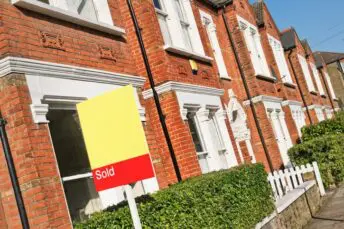House Price Watch Mar 2024
Overall market indicators remain positive into March with buyer demand up again and the flow of new homes for sale also up. However, the market remains price sensitive with affordability pressures still present -- house prices have dipped this month but remain up year on year. The near-term outlook remains cautious as the decline in mortgage rates that had helped to drive market activity around the turn of the year has stalled with uncertainty around the timing of Bank of England rate cuts.
What’s happening nationally
House prices are down on average -0.3% over the past month and up on average +0.6% over the past year.
There was a varying picture in house price fluctuations reported by the indices this month. Both Halifax (-1%) and Nationwide (-0.2%) reported a fall in house prices over the past month, Land Registry reporting February figures reported a rise in monthly house prices (+0.4%) and Rightmove reported a 1.5% increase in asking prices in March. With the exception of Land Registry, the major indices are showing positive annual house price growth.
Indices based on:
Land Registry – registered property transactions in February.
Nationwide & Halifax – mortgage valuations in March.
Rightmove – asking prices posted on Rightmove in March.
*Rightmove is not included in the index average as the basis for its index is different (asking price vs agreed sale price)
| Index reports: | Monthly change | Annual change |
|---|---|---|
| Land registry | +0.4% | -0.2% |
| Nationwide | -0.2% | +1.6% |
| Halifax | -1.0% | +0.3% |
| Rightmove | +1.5% | +0.8% |
| Average change | -0.3% | +0.6% |
House prices in your area
House price fluctuations over the past month show a mixed picture across the UK with Land Registry reporting house prices up in Wales (+0.4%) and in many areas of England including the North East (+3.2%), East of England (+1.7%), East Midlands (+1.4%), South East (+1.1%), Yorkshire & Humber (+0.9%) and the South West (+0.5%).
House prices fell over the past month in Scotland (-0.6%), Northern Ireland (-0.9%), the West Midlands (-1.2%), London (-0.7%) and the North West (-0.2%).
Average house prices remain highest in London (£503K) and lowest in the North East (£160K).
In terms of monthly house price shifts by type of property, detached homes were up +0.5%, semi detached properties up +0.7%, terraced properties were down -1.0% and flats/ maisonettes down -1.0% according to February Land Registry data.
| UK Region | Average price £ | Monthly change | Annual change |
|---|---|---|---|
| England | |||
| Nothern Ireland | |||
| Scotland | |||
| Wales | |||
| North West | |||
| Yorkshire and The Humber | |||
| North East | |||
| West Midlands | |||
| East Midlands | |||
| South West | |||
| East of England | |||
| South East | |||
| London |
| UK City | Average price | Annual change |
|---|---|---|
Market Monitor
There were 83K transactions in February 2024, up 1% on January but 6% lower than February 2023. Transactions continue to be at their lowest level in 10 years (excepting the period of the pandemic in 2020).
Demand continues to pick up with new buyer enquiries up. New sales instructions were also up this month. Average stock per agent has increased month on month.
Time to sell has dropped to 71 days from 78 days last month but is still up significantly from a year ago (57 days last year at this time).
How busy is the market?
- Not busy
- Normal
- Very busy
- Transactions up slightly in February but still at a ten year low.
- Total transactions in February 2024 83K
- +1% from last month
- -6% from February last year
Homes for sale vs homebuyers
- Good availability of homes
- Normal
- Shortage of homes
- Buyer enquiries up(+8% RICS); demand up 3 months in a row
- Seller enquiries up (+13% RICS); improving stock availability
- Average stock per agent 51; up from 49 last month (incl under offer/ Sold STC Rightmove)
Average speed of sale
- Fast
- Normal
- Slow
- 71 days to find a buyer down from 78 days in January (up from 57 days last February, Rightmove)
What the experts say
Rightmove - agent's view

“Despite a better-than-expected start to the year, the market remains sensitive to pricing and external events. Rightmove’s real time data shows the growth in buyer demand was tempered somewhat by a lacklustre Spring Budget, with no direct help for first-time buyers or mortgage market innovations. The average time to find a buyer is 71 days, the longest at this time of year since 2019. Attractively priced properties are quickly being cherry-picked, but over-optimistically priced sellers are taking longer to find a buyer. The average 5-year mortgage rate is now 4.84% compared to 4.64% five weeks ago, as rates edge up to higher levels.”
Nationwide

“Activity has picked up from the weak levels prevailing towards the end of 2023 but remains relatively subdued by historic standards. The number of mortgages approved for house purchase in January was around 15% below pre-pandemic levels. This largely reflects the impact of higher interest rates on affordability. While mortgage rates are below the peaks seen in mid-2023, they remain well above the lows prevailing in the wake of the pandemic. With cost-of-living pressures easing as inflation moves back towards target, consumer sentiment is improving. Indeed, surveyors report a pickup in new buyer enquiries and new instructions to sell in recent months. Moreover, with income growth continuing to outpace house price growth by a healthy margin, housing affordability is improving, albeit gradually. If these trends are maintained, activity is likely to gain momentum, though the pace of the recovery is still likely to be heavily influenced by the trajectory of interest rates.”
Halifax

“Affordability constraints continue to be a challenge for prospective buyers. Financial markets have become less optimistic about the degree and timing of Base Rate cuts, as core inflation proves stickier than generally expected. This has stalled the decline in mortgage rates that had helped to drive market activity around the turn of the year. The housing market remains sensitive to the scale and pace of interest rate changes, and with only a modest improvement in affordability on the horizon, this will likely limit the scope for significant house price increases this year.”
Zoopla (Hometrack)

“All the primary measures of sales market activity continue to show positive, upward momentum but sellers need to remain realistic on where they set the asking price if they are to take advantage of improving market conditions to secure a sale and move home in 2024.The percentage of the asking price achieved has narrowed from 95.5% in November 2023 to 96.1% in March 2024. Sellers are accepting a median average discount to the asking price of £10,000, down from £14,250 in Nov 2023.”
RICS

“The March 2024 RICS UK Residential Survey results remain indicative of a steady improvement in overall sales market conditions. Indeed, buyer demand continues to edge higher, while near term expectations point to activity gaining further traction over the coming months. Alongside this, house prices have stabilised at the headline level, with forward-looking metrics suggesting that an upward trend may emerge later in the year.”




